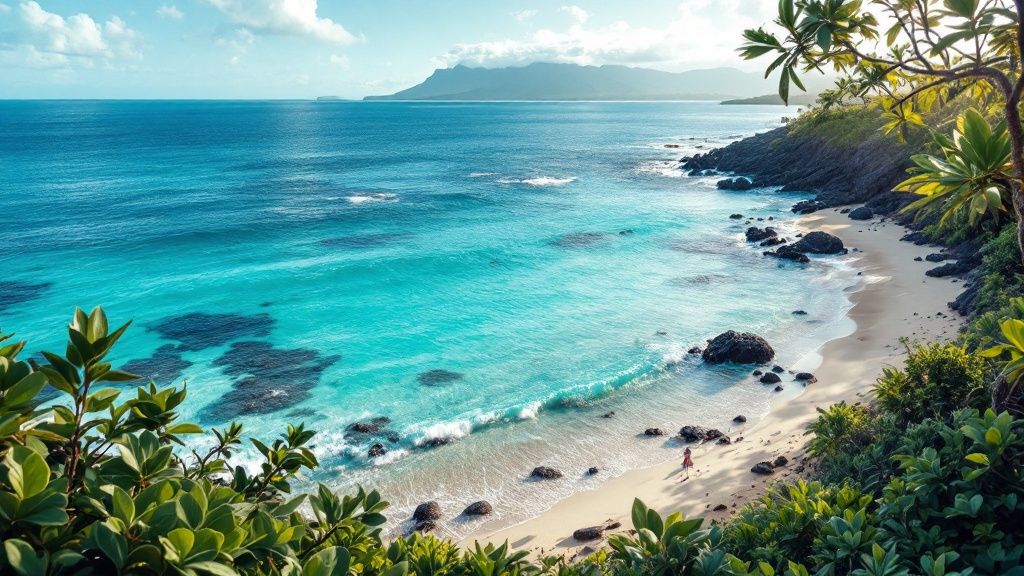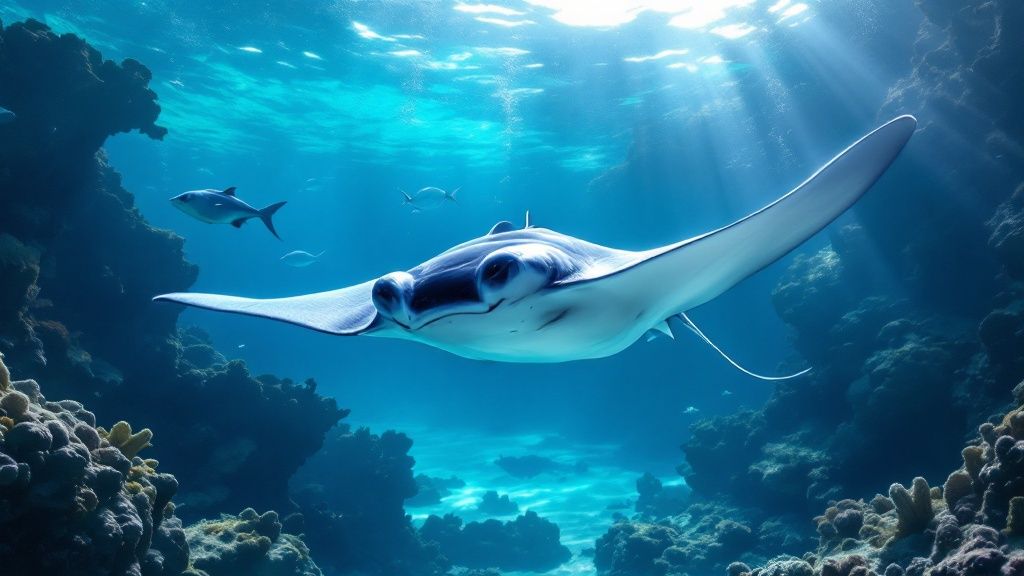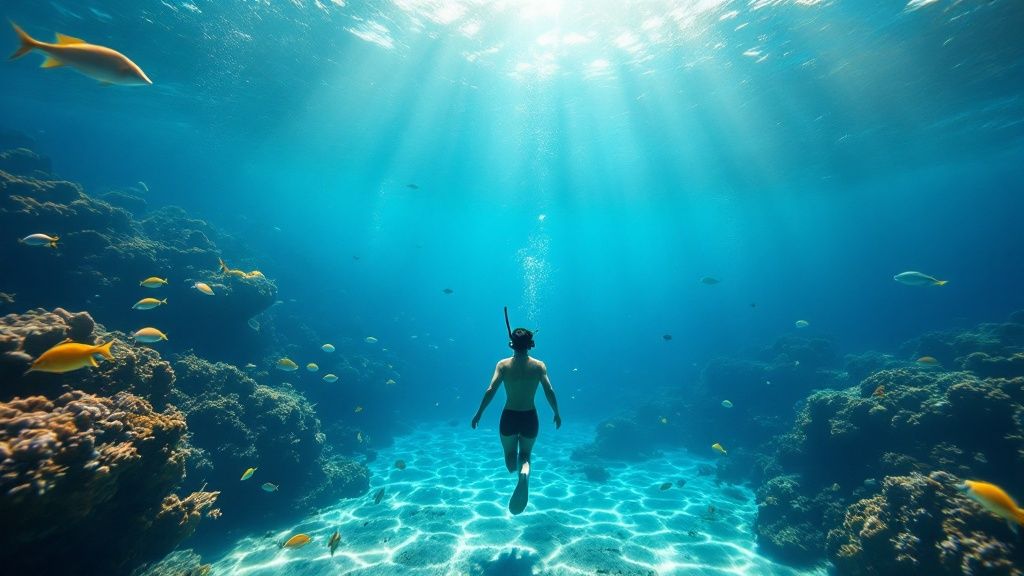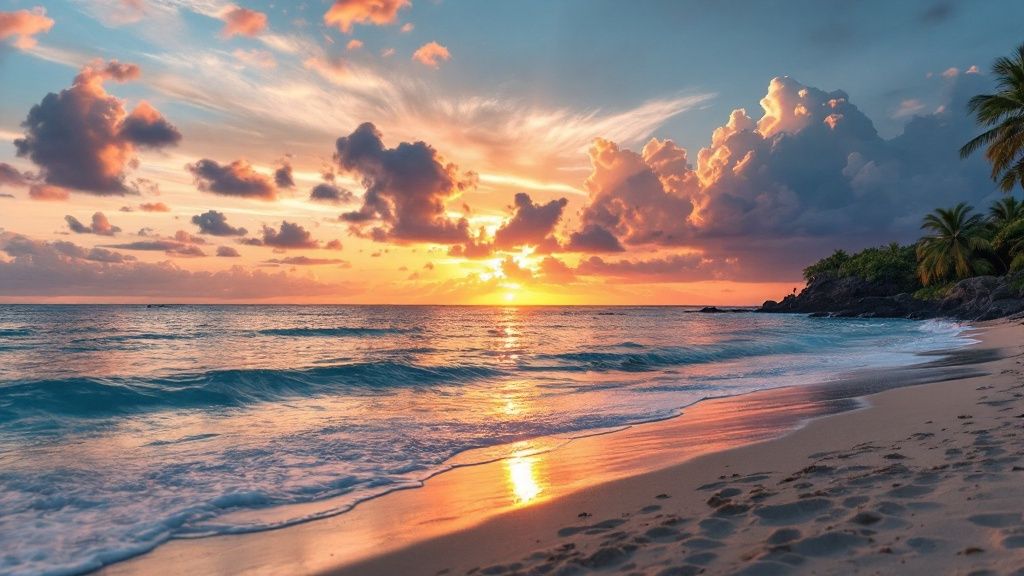Manta Ray Snorkeling Big Island: Top Encounters
- Byron
- Mar 25
- 13 min read
The Magic of Manta Ray Snorkeling Big Island
Imagine floating beneath the Hawaiian night sky, the gentle rhythm of the waves your only companion. Suddenly, a graceful manta ray emerges from the darkness, its 10-foot wingspan a breathtaking sight just inches below. This is the magic of manta ray snorkeling on the Big Island, an unforgettable experience that often becomes a cherished memory for visitors.
This encounter isn't just about seeing these gentle giants; it's about connecting with them. The nighttime setting adds to the wonder, creating an ethereal atmosphere where the manta rays seem to dance in the underwater lights. This intimate experience fosters appreciation for these ancient creatures and encourages respect for their conservation.
Why the Big Island? A Perfect Convergence
The Big Island offers an ideal environment for manta ray encounters. Volcanic activity creates nutrient-rich waters, attracting plankton, the manta rays' main food source. Ocean currents deliver this plankton to specific locations, creating predictable feeding grounds. This allows tour operators to bring snorkelers to areas where manta ray sightings are practically guaranteed.
The Big Island's exceptionally clear water further enhances the experience. Even at night, visibility is often remarkable, providing stunning views of these magnificent creatures as they perform their captivating feeding rituals.
From Local Treasure to Global Wonder
Manta ray snorkeling on the Big Island has grown in popularity, especially following the 2020 legislation restricting dolphin interactions. This growth can be attributed to the unique and responsible way it allows interaction with marine life. Snorkelers float on illuminated boards that attract phytoplankton, drawing in the manta rays. The clear, warm water provides excellent visibility, even at night. For safety and environmental responsibility, book tours with reputable operators like Sea Quest Hawaii.
What was once a local secret is now a world-renowned experience. However, the Big Island has preserved the wonder of these encounters. Reputable tour operators prioritize sustainable practices, minimizing disruption to the environment and the manta rays. This commitment to responsible tourism ensures future generations can also witness this magical experience.

Prime Locations for Manta Ray Snorkeling Big Island
Not all manta ray snorkeling sites are created equal. This section breaks down the best spots on the Big Island for maximizing your encounter potential. We'll explore the unique characteristics of two famed locations: Manta Village (Keauhou Bay) and Manta Heaven (Makako Bay).
Manta Village: A Shallow-Water Spectacle
Manta Village in Keauhou Bay is known for its shallow, calm waters. This makes it perfect for beginners and families. The bay floor, a mix of smooth sand and coral rubble, offers clear views of the manta rays as they feed just below the surface. The shallow depth maximizes light penetration, enhancing visibility, even at night. This allows for incredible up-close views of these gentle giants. You might be interested in our sitemap for more information about us.
Manta Heaven: Deeper Waters, More Dynamic Encounters
Manta Heaven, located in Makako Bay, offers a different experience. Characterized by deeper waters and stronger currents, it creates a more dynamic encounter for experienced snorkelers. The diverse topography, with coral formations and volcanic rock structures, provides a rich environment for plankton, attracting larger numbers of manta rays. The deeper water can be more challenging for those less comfortable in the ocean. Manta Heaven is generally recommended for strong swimmers.
Choosing the Right Spot for You
Choosing the right spot depends on your experience level, physical abilities, and the time of year. Manta Village offers a comfortable introduction to manta ray snorkeling for beginners. For a more adventurous experience, Manta Heaven provides thrilling encounters with larger groups of mantas. Water conditions and manta ray activity vary seasonally. Consulting with local experts and tour operators will help you choose the best site.
The Kona Coast of the Big Island is renowned for its regular manta ray sightings. Between 2009 and 2014, underwater videographers at 'Manta Village' and 'Manta Heaven' kept detailed records, revealing consistent patterns and helping predict sightings. These studies, including monitoring individual mantas and logging monthly statistics, contributed to understanding their habitat and migration patterns. This research benefits tourism and supports conservation by identifying trends and areas of high manta ray activity. Find more detailed statistics here.
Exploring Beyond the Famous Two
While Manta Village and Manta Heaven are popular, the Big Island offers lesser-known snorkeling spots. Some small-group operators venture to these secluded sites, offering intimate encounters away from the larger tour groups. These hidden gems provide unique opportunities to observe manta rays with fewer distractions. This adds another dimension to the experience. These tours often have specific conditions, including longer boat travel times. Researching and selecting the right tour is crucial for your comfort and desired experience.

Inside a Manta Ray Snorkeling Big Island Experience
From booking your tour to sharing your incredible photos afterward, a manta ray snorkeling adventure on the Big Island is an experience unlike any other. This section takes you behind the scenes, revealing what you can expect from start to finish.
From Booking to Boat: Preparing for Your Adventure
The journey begins long before you enter the water. Choosing the right tour operator is crucial for a positive experience. An exceptional operator prioritizes small groups, ensuring a personalized experience with knowledgeable guides. They also offer high-quality equipment, including wetsuits and snorkel gear, minimizing discomfort and maximizing your enjoyment. You might be interested in: our blog post sitemap for additional resources.
Look for operators who emphasize sustainable practices, respecting both the mantas and their environment. This is a key factor in preserving this incredible experience for future generations. Careful planning and selection ensures your adventure starts off on the right fin.
On the Water: Setting the Stage for Encounters
Once aboard the boat, the anticipation builds. A short ride to the snorkeling site provides ample time for a safety briefing and an overview of manta ray behavior. Experienced guides share fascinating facts about these gentle giants, enhancing your understanding and appreciation.
As the sun dips below the horizon, the stage is set for a truly magical encounter. The transition from day to night adds an element of mystery and excitement to the experience.
The Manta Moment: A Dance in the Dark
Entering the dark ocean can be daunting for some, but the presence of expert guides quickly puts anxieties at ease. Floating on the surface, holding onto a lit flotation device, you’ll watch as plankton, drawn by the light, gather beneath you.
This attracts the manta rays, who gracefully glide into view. Their movements are a mesmerizing ballet in the illuminated water. These moments, with mantas swirling just inches away, are truly unforgettable.
Choosing Your Experience: Group Size and Operator Expertise
Manta ray snorkeling and diving tours on the Big Island offer a high success rate of spotting these creatures. Jack's Diving Locker reports seeing manta rays about 85-90% of the time, although sightings are never guaranteed as they are wild animals. Find more detailed statistics here.
These tours provide opportunities to learn about manta rays and the local ecosystem while ensuring responsible interaction. Choosing a tour operator with a strong commitment to wildlife protection and small group sizes enhances the experience while contributing to conservation efforts.
To help you choose the right tour, we've compiled a comparison table:
Introduction to table: The following table compares different manta ray tour options available on the Big Island, allowing you to select the experience that best suits your needs and preferences.
Tour Type | Typical Duration | Best For | Average Cost | What's Included |
|---|---|---|---|---|
Small Group Snorkel | 2-3 hours | Personal experience, close encounters | $150-$200 | Snorkel gear, wetsuit, flotation device, guided tour |
Large Group Snorkel | 1.5-2 hours | Budget-conscious travelers | $100-$150 | Snorkel gear, flotation device, guided tour |
Private Charter | Flexible | Families, groups, personalized itinerary | $500-$1000+ | Customized experience, snorkel gear, food and beverages |
Dive Tour | 2-3 hours | Certified divers | $180-$250 | Dive gear, guided dive |
Conclusion of table: As you can see, there are various tour options available, catering to different budgets and preferences. Consider factors like group size, included amenities, and overall experience when making your selection.
Addressing Common Concerns: Swimming Ability and Darkness
Even if you're not a strong swimmer, or if the darkness makes you nervous, you can still enjoy this unique experience. Many operators provide flotation devices and attentive guides who offer support and reassurance throughout the snorkel.
Remember, the focus is on observing these magnificent creatures, not on athletic prowess. The guides are there to ensure everyone has a safe and memorable encounter, regardless of their comfort level in the ocean.

Understanding The Giants: Manta Biology and Conservation
Transforming a simple snorkeling trip into a meaningful wildlife interaction begins with understanding the remarkable manta rays. These gentle giants possess unique adaptations that distinguish them in the ocean. Learning about their biology and the conservation efforts surrounding them will deepen your appreciation. You might be interested in our blog category sitemap for related articles.
Reef Manta Vs. Oceanic Manta: Spotting The Difference
Off the Big Island, you're likely to encounter two types of manta rays: reef mantas (Mobula alfredi) and oceanic mantas (Mobula birostris). Reef mantas, true to their name, prefer shallower coastal reefs. Oceanic mantas, on the other hand, venture into the deeper open ocean.
Distinguishing between them can be tricky. Look for subtle differences in their dorsal color patterns and markings around their mouths. Each manta also has unique ventral markings, much like fingerprints. These markings allow researchers and guides to identify individual mantas.
A Fish With A Big Brain: Manta Intelligence
Manta rays boast one of the largest brain-to-body ratios of any fish. This intelligence translates into complex social behaviors and impressive navigation abilities. They use their cephalic fins—extensions of their pectoral fins that resemble horns—to funnel plankton-rich water into their mouths.
This clever feeding strategy demonstrates their adaptability and resourcefulness, allowing them to thrive in diverse ocean environments.
Conservation Challenges and The Role of Tourism
An estimated 80,000 people participate in manta ray snorkeling and diving annually on the Big Island, especially along the Kona Coast. This area offers a unique opportunity to see both the reef manta ray and the giant manta ray. The latter can have a wingspan of up to 26 feet.
These gentle giants hold a significant place in Hawaiian culture, even appearing in ancient chants like the kumulipo. Learn more about manta rays in Hawai’i here.
Manta ray populations face several threats. These include bycatch (accidental capture in fishing nets), habitat degradation, and pollution. However, responsible tourism plays a vital role in conservation.
Snorkeling tours contribute to research funding and raise public awareness about these magnificent creatures. This awareness is key to promoting responsible interactions and supporting long-term protection efforts.
Becoming A Manta Advocate: What You Can Do
By understanding manta ray biology and the challenges they face, you can contribute to their protection. Choosing sustainable tour operators is a great start. Following responsible snorkeling guidelines and spreading awareness among fellow travelers also amplifies the positive impact of tourism.
This transforms your snorkeling experience from a fleeting moment of awe into a lasting contribution to ocean conservation. Every action, no matter how small, makes a difference in the lives of these gentle giants.

Responsible Practices for Manta Ray Snorkeling Big Island
Experiencing the magic of manta rays beneath the Hawaiian night sky is truly unforgettable. However, it's essential to ensure these encounters are sustainable and respectful to these gentle giants. This goes beyond basic etiquette and requires understanding what responsible manta ray tourism truly means.
Choosing a Sustainable Tour Operator
Identifying truly committed tour operators requires looking beyond marketing buzzwords. Look for companies actively involved in conservation initiatives, demonstrating a commitment to small group sizes, and prioritizing education along with entertainment. These operators understand the delicate balance between wildlife viewing and its potential impact.
They educate guests about proper in-water behavior and actively minimize disturbances to the manta rays' natural feeding patterns. This ensures the experience is enriching for visitors while respectful of the animals.
Recognizing Overcrowding and Prioritizing Welfare
Overcrowded snorkeling sites can stress manta rays and detract from the overall experience. Responsible operators avoid these situations and prioritize the animals' welfare over photo opportunities.
Warning signs of an overcrowded site include numerous boats clustered together and large groups of snorkelers in the water simultaneously. Avoid companies that rush the experience or encourage disruptive behavior for better photos. These practices can negatively impact the manta rays and diminish the quality of the encounter for everyone.
Addressing Ethical Considerations: Group Size and Lighting
The number of people participating in manta ray snorkeling raises important ethical questions. What is the appropriate group size? Are current lighting practices sustainable? These are complex issues requiring input from marine biologists and conservation experts.
Safety assessments conducted for manta ray viewing operations at locations like Makako Bay and Keauhou Bay highlighted several concerns. As of 2015, at least 42 commercial tour operators were active in these areas. The number of vessels and people in the water often exceeded 290 people on busy nights, contributing to safety risks. Explore this topic further here. Evidence-based recommendations often suggest smaller group sizes and responsible lighting practices that minimize disruption to the mantas' natural behaviors.
Respecting Hawaiian Culture and the Hahalua
Gaining perspective from Hawaiian cultural practitioners enriches the manta ray experience. Traditionally known as hahalua, mantas hold a special place in Hawaiian culture. Learning about these traditional relationships informs modern interactions and promotes deeper respect for the animals and their environment.
This cultural understanding fosters a sense of responsibility and ensures these magnificent encounters remain possible for future generations. It means approaching these encounters with humility and recognizing the cultural significance of these animals in Hawaiian traditions.
Ensuring Sustainable Encounters for Generations to Come
Responsible manta ray snorkeling involves making informed choices. By choosing sustainable tour operators, respecting the environment, and understanding the cultural significance of these animals, we can help ensure these magnificent encounters remain possible for generations to come. This approach not only protects the manta rays but also enhances the experience for everyone. It allows us to appreciate the beauty and wonder of these gentle giants while contributing to their long-term well-being.
Insider Secrets for Unforgettable Manta Ray Encounters
So, you're ready to experience the magic of manta ray snorkeling on the Big Island? This guide takes your experience from good to extraordinary, sharing insider tips from veteran guides and professional underwater photographers.
Timing Is Everything: Moon Phases and Seasonal Patterns
Believe it or not, the moon plays a crucial role in manta ray feeding habits. Plankton, the manta's primary food source, is more abundant during a full moon. This creates a feeding frenzy, attracting larger numbers of mantas for a truly spectacular display.
Certain seasons also offer better viewing opportunities. While manta rays grace Hawaiian waters year-round, the summer months (June-August) generally boast calmer waters and improved visibility. Keep in mind, this is peak tourist season. Booking your tour well in advance is highly recommended.
To help you plan your trip, take a look at the manta ray sighting probability table below. It showcases the best times to visit based on historical sighting data.
Month | Manta Village Sighting % | Manta Heaven Sighting % | Average Group Size | Best Time to Go |
|---|---|---|---|---|
January | 85% | 90% | 8-10 | Good |
February | 90% | 92% | 10-12 | Excellent |
March | 92% | 95% | 12-15 | Excellent |
April | 90% | 92% | 10-12 | Excellent |
May | 88% | 90% | 8-10 | Good |
June | 85% | 88% | 6-8 | Good |
July | 80% | 85% | 5-7 | Fair |
August | 75% | 80% | 4-6 | Fair |
September | 80% | 85% | 5-7 | Fair |
October | 85% | 90% | 6-8 | Good |
November | 90% | 92% | 8-10 | Excellent |
December | 92% | 95% | 10-12 | Excellent |
As you can see, the months of February, March, and April offer the highest chances of spotting large groups of manta rays. While summer offers calmer waters, the sighting percentages are slightly lower.
Positioning for the Perfect View: A Manta's Perspective
Most tours use lights to attract plankton, which in turn, draws the manta rays. However, simply being near the light isn't enough for an optimal view. Position yourself downstream from the light source. This allows you to observe the mantas as they gracefully glide towards the illuminated plankton. Avoid excessive movement, which can disturb the mantas. Think like a manta—they appreciate calm, steady observers.
Staying Present: Managing Anxiety and Sensory Overload
The nighttime ocean can feel overwhelming, especially for first-time snorkelers. The darkness, coupled with the excitement of seeing manta rays, can trigger mild anxiety. Practice deep, slow breaths before entering the water to promote relaxation. Focus on the gentle rhythm of the waves and the mesmerizing movements of the mantas.
Mask fogging is another common issue. Use anti-fog solution before your snorkel. If needed, briefly dip your mask in the water to clear any fog during the experience. These practical steps ensure a clear view, minimizing distractions.
Capturing the Magic: Underwater Photography Tips
Documenting your manta ray encounter can truly enhance the memory. Even with basic equipment, you can capture stunning images. Professionals recommend a fast shutter speed to freeze the manta's motion and a wide-angle lens to capture their full wingspan. Red light disappears quickly underwater, so adjust your white balance or use a red filter.
If you're not comfortable with underwater photography, simply enjoy the moment. Many operators offer photography packages. Some, like Hang Loose Boat Tours, guarantee sightings and offer a free repeat tour if no manta rays are spotted. This allows you to fully immerse yourself in the experience.
From Fumbling First-Timer to Confident Explorer
These insider secrets empower you to connect with these gentle giants on a deeper level, transforming your snorkeling experience into a cherished memory. By understanding manta ray behavior, practicing mindful presence, and utilizing simple photography techniques, you'll be well on your way from a fumbling first-timer to a confident ocean explorer.
Planning Your Manta Ray Snorkeling Big Island Adventure
Turning your dream of snorkeling with manta rays into a reality starts with a well-thought-out plan. This guide provides a framework to help you maximize your chances of an unforgettable encounter, while ensuring it seamlessly integrates into your Hawaiian getaway.
Booking Your Adventure: Timing Is Key
Booking your manta ray snorkeling tour ahead of time is essential, particularly during the popular season from April to October. Manta rays grace Hawaiian waters year-round, but summer boasts calmer waters and enhanced visibility. This also translates to higher demand. Booking at least two weeks before your target date is a smart move.
For maximum flexibility, schedule your manta ray snorkel early in your Big Island trip. Many reputable operators offer a "manta ray guarantee," providing a free repeat tour if mantas aren't spotted on your first outing. This safety net ensures you won't miss this incredible experience due to unforeseen circumstances.
Choosing The Right Operator: Beyond The Basics
The tour operator you choose significantly influences your overall experience. Don't just focus on price; consider smaller group sizes for a more personalized and intimate encounter. Prioritize operators emphasizing sustainable practices, as responsible tourism is vital for manta ray conservation. This includes adhering to guidelines on boat traffic, lighting, and respectful interaction distances.
Research the operator's experience and expertise. Knowledgeable guides enhance the experience by sharing insights into manta ray behavior and biology. They also prioritize participant safety and comfort, especially for first-time snorkelers or those who might feel anxious about swimming in the open ocean at night.
Transportation and Logistics: Minimizing Stress
Planning your transportation to and from the tour departure point minimizes pre-trip stress. Most tours depart from the Kona area. Account for potential traffic, especially during peak tourist season. If you aren't staying near Kona, consider pre-arranged transportation or allotting extra travel time.
Think about the tour's duration when structuring your day. Manta ray night snorkeling tours typically last 1.5-3 hours. Include extra time for check-in, the boat ride, and changing into and out of wetsuits. This allows for a relaxed experience without feeling rushed.
Weather Contingencies: Be Prepared
While summer generally offers optimal conditions, Big Island weather can be unpredictable. Have backup plans in case your tour is canceled due to inclement weather. Consider booking activities that are enjoyable regardless of weather, ensuring a fulfilling trip. This highlights the importance of a flexible itinerary.
Special Considerations: Families, Seniors, and Accessibility
Manta ray snorkeling is generally inclusive, but certain groups may require special considerations. Families with young children should inquire about age restrictions and child-friendly equipment. Seniors and those with accessibility needs should discuss any physical limitations with the tour operator beforehand. This ensures appropriate accommodations for a comfortable and safe experience.
If you have health concerns such as seasickness, consult your doctor and consider preventative measures. Many operators offer helpful advice and resources to minimize discomfort.
By addressing these planning elements, you're setting the stage for a truly memorable encounter with the majestic manta rays of the Big Island. Turn your dreams into lasting memories.
Book your unforgettable Manta Ray Night Snorkel adventure today! Experience the magic of manta rays with Manta Ray Night Snorkel Kona Hawaii Tours
Comments